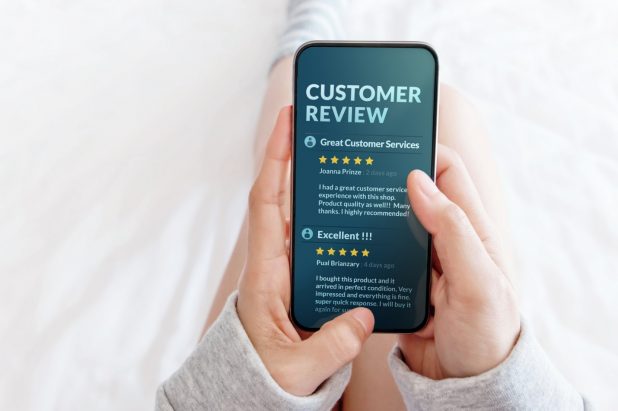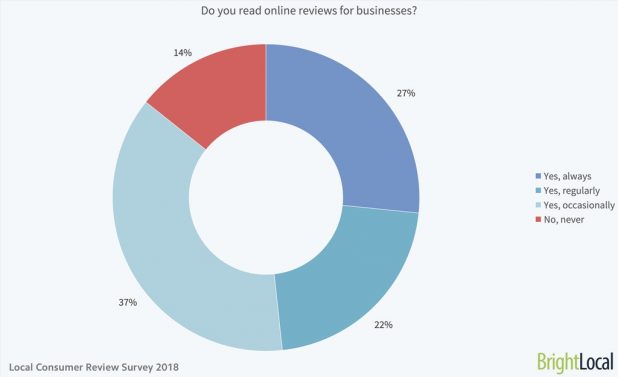How to Ensure the Right People Actually See Your Customer Reviews

Customer reviews are crucial to your online business for many reasons. They serve as social proof, which helps encourage others to buy, and they also help establish trust and credibility with your audience. In the case of local businesses, they are known to help with SEO efforts as well.
When done right, reviews can help increase your conversion rates, which ultimately puts more money in your pocket.
Think about the last time you tried something without a recommendation –from a friend, a family member, or an online review. Chances are, it’s been a while. The majority of customers, 86% of them, read online reviews before they make a purchase, and almost half of them will only trust reviews that are four stars or better. Perhaps even more important is that 84% of customers surveyed said they trust those online reviews as much as a personal recommendation from someone they know.

Image Source: brightlocal.com
Not only does it affect how prospective customers perceive your company or its products and services, customer reviews make a difference in terms of the search engines, too. And because the search engines control who finds your website when they’re searching for something you offer, you want to do what you can to keep them happy, right?
“Interact with customers by responding to reviews that they leave about your business,” recommends one Google My Business support page. “Responding to reviews shows that you value your customers and the feedback that they leave about your business. High-quality, positive reviews from your customers will improve your business’s visibility and increase the likelihood that a potential customer will visit your location.”
That said, getting customers to leave reviews and responding to them is only half the battle. You have to make sure your prospective customers will see them, too. How do you do that?
Cover the Most Popular Review Platforms
Perhaps the best example of a business that naturally attracts reviews is Neil Patel, whose various projects see a good amount of coverage in the form of user-generated content, whether it’s quick ratings and reviews of his Marketing School podcast on leading podcast distribution platforms or longer reviews of the Neil Patel Digital agency. But we don’t all have the visibility and brand recognition that Neil Patel’s name has, so the rest of us are better off looking to focus our customer review activity on platforms that see the most traffic and are easiest to post on.
If you’re not sure where to get started, the vast majority of internet users will rely on one of the three following review platforms, which have a combined average of about 300 million visitors every month.
Though the statistics vary from industry to industry, a combined 83% of consumers looking for service-based businesses rely on these top three platforms.
The important thing is that you are where your customers are, and that your customers have the choice to leave a review where they feel most comfortable. If someone has to create an account to leave a review for your business, for example, then they aren’t likely to do it.
Facebook is one of the most popular platforms on the internet, just behind Google and YouTube, with more than 2.2 billion users. Making it easy for people to leave you reviews right on your Page is one of the best ways to get people to write business reviews.
First, make sure the option to leave reviews is turned on in your Page settings. Once you know they’re on, make sure they’re visible to your page visitors. Above where you turned on the reviews option, you’ll see templates to choose from – if you can’t find one you like, the default “Business” option makes reviews visible.
Yelp
If you’re a local business, you need to be on Yelp. It’s a bit more difficult to manage than Facebook or Google, because it places weight on reviews differently. Much like Google’s algorithm, Yelp aims to show content that it deems most helpful. They consider the overall reviewer history, the feedback left on each review, and the quality of the reviews you already have to determine how they’re going to incorporate each additional review.
Be careful, though, because outright asking for a review or incentivizing it in any way is against Yelp’s terms of service, which can get your business page completely removed from the platform.
Google My Business
If you haven’t already, visit Google My Business to claim your profile. Enter as much of the profile information as possible because the more complete your profile is, the better. You may find that you already have a profile there with reviews on it – just search your business in Google, and if you find that it comes up in the local map pack, you can claim the profile. All you have to do is verify that you are the business owner.
If you find that you already have a profile with reviews, after you claim the profile and enter the information, take the time to reply to each of the reviews, whether positive or negative. Address the negative reviews with empathy and encourage the reviewer to reach out to you via email so you can make the situation right.
Include Reviews as Social Proof on Your Website
Social proof is like wisdom of the crowd, and people want to be like everyone else on a deep psychological level. By cherry picking your best reviews from across various platforms and including them throughout your website – on your homepage, feature-specific reviews on your landing pages and so on – you can increase your conversion rates.
When you take screenshots of reviews from various platforms, in addition to sharing them on your website, you can share them on your social media platforms and give the reviewer a shout out.
When it comes to leveraging reviews to grow your business, you must be patient. Keep providing a quality product or service and customer experience that makes people want to leave you a review. Make it easy for people to leave reviews where you want them to, by linking to your profiles in your follow up emails. Take the time to thank people for their feedback. When you get a good review, celebrate, and use it to encourage current and past customers to leave you a review.
Eventually, the reviews will start coming in without as much effort and will work to boost your sales.



